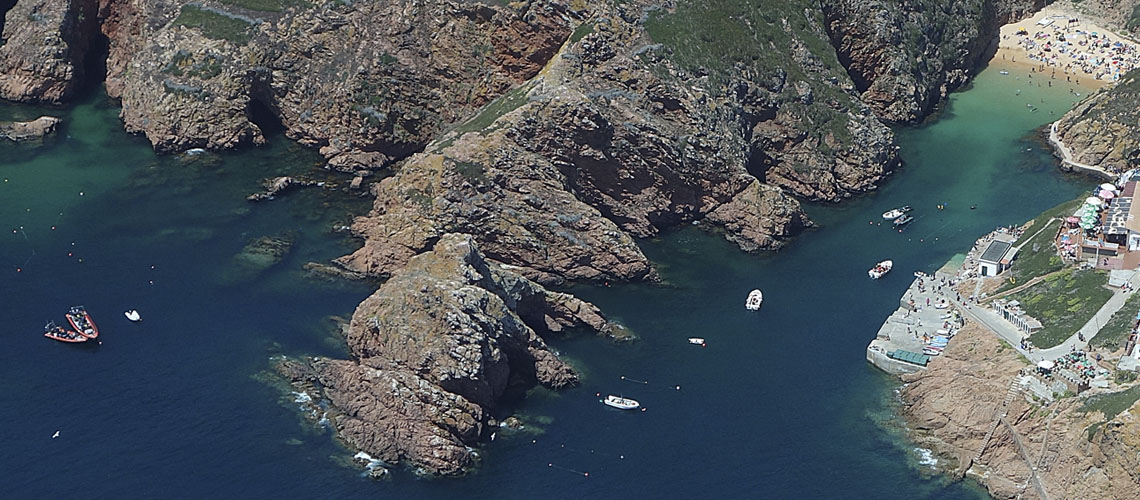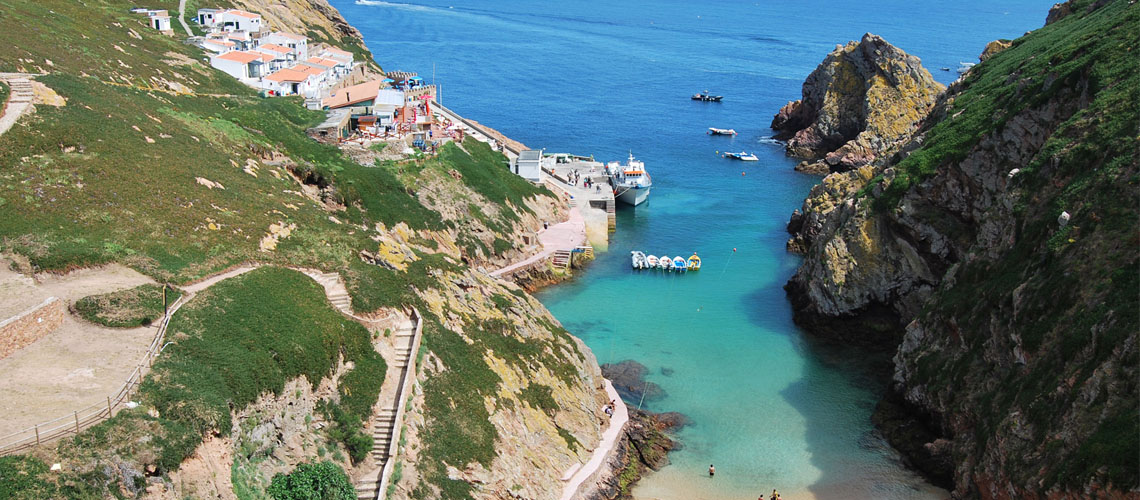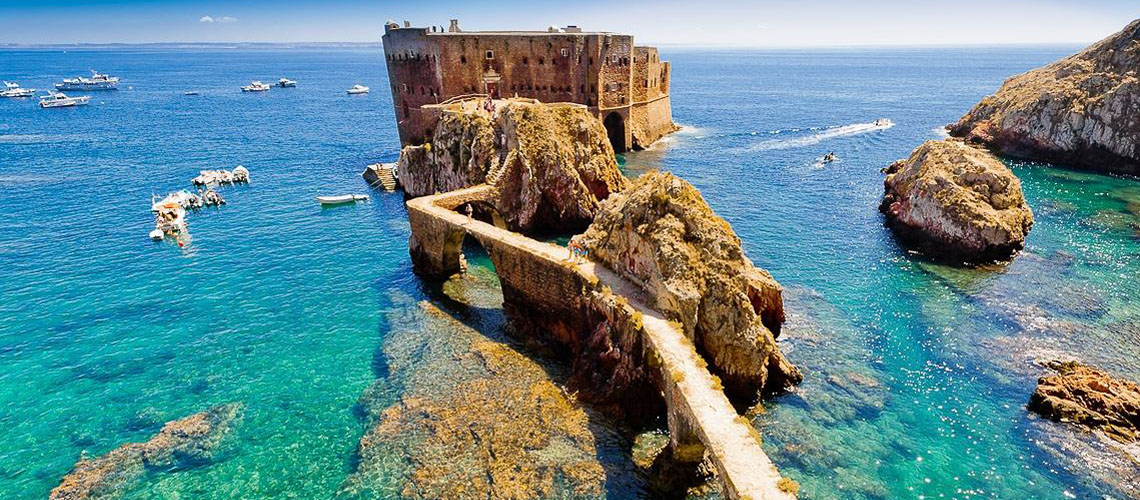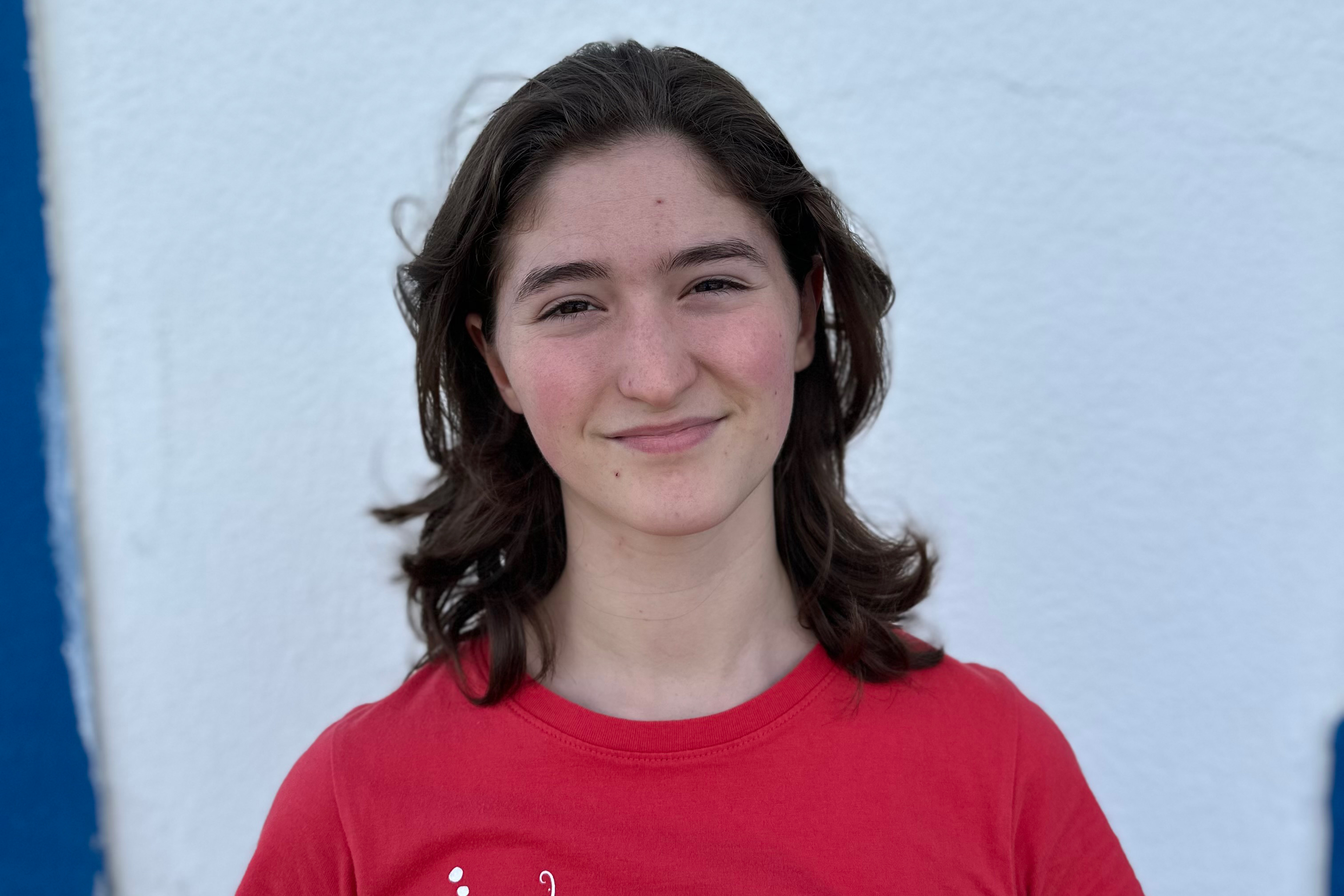Double Freedive Trip
Mars 01
Emplacement unique en
raison de la propriété sous-marine.

O pequeno arquipélago das Berlengas, situado a cerca de 10km a oeste de Peniche, é constituído pela ilha da Berlenga Grande e recifes adjacentes, as Estelas e os Farilhões-Forcados, estando classificado como Reserva Natural desde 3 de Setembro de 1981.
A Reserva Natural da Berlenga é um local único devido à transparência das suas águas e espólio sub-aquático. É uma reserva marinha e está classificada como "Reserva da Biosfera" pelo Conselho da Europa e desde 2011 "Reserva Mundial da Biosfera", pela Organização das Nações Unidas para a Educação, Ciência e Cultura (UNESCO).
O arquipélago é constituído por uma ilha, Berlenga Grande e por alguns ilhéus graníticos e rochedos (Estelas e Farilhões) e fica a 7 milhas do Cabo Carvoeiro a noroeste de Peniche. A Berlenga Grande avista-se do território continental quando não há neblina. Podemos encontrar aqui espécies endémicas de flora, além de ser local de eleição para a nidificação de aves marinhas.
Na Berlenga sobre o ilhéu, ergue-se o Forte de São João Baptista, fortaleza militar manuelina, datada de 1502 e ligada à ilha por uma pequena ponte.As pequenas praias de águas transparentes são muito bonitas e ideais para uns bons mergulhos.
O acesso à ilha é feito por barco, o Cabo Avelar Pessoa, que se pode apanhar no porto de Peniche. Demora cerca de 30 minutos a chegar à Berlenga Grande. Poderá regressar ao final da tarde ou pernoitar na fortaleza, existindo também um restaurante na ilha.
*A informação presente nesta página foi obtida no site do ICBN, Turismo de Portugal e Candidatura das Berlengas a Reserva da Biosfera da UNESCO.

Geographic caracteristics
The Natural Reserve of the Berlengas extends over a vast marine area of approximately 9.560 ha (on land ca. 104ha and ca. 9.456ha of marine territory).
This archipelago consists of small islands and riffs with an irregular shape, with steep slopes, and consists of three groups: Berlenga, Estelas and Farilhões-Forcadas. The archipelago sits on the continental shelf, about 6 miles west of Cabo Carvoeiro, close to the town of Peniche.
Climate
The archipelago of the Berlengas is located in a temperate maritime climate zone, characterized by temperate summers, with monthly averages rarely lower than 20°C and daily maximum teperatures not higher than 32°C. The winters are mild, monthly averages stay around 10°C and the minimum temperature drops seldomly below 0°C. The climate lacks extremes, but it tends to be foggy during summer. The wind usually comes from a Northern direction during spring and summer, and more from a Western-Southwestern direction during the rest of the year.
The North-South orientation of Portugal’s coast is also a determining factor of the climate and the oceanography, especially during the summer. During this season the water and land surfaces heat up and provoke a marine wind during the day. This phenomenon is known as “Nortada” and is connected on a bigger metereological scale to the anticiclone of the Azores. They force the surface waters of the ocean to move and give way, and therefore provoke an exchange of the warmer surface water against cooler water from futher down.
This phenomenon, also known as trade winds, also provokes dense and frequent fog during summer along the coast (consequence of dropping air temperatures and condensation of humidity in the air. Surface water enriches in nutritients, which are usually more abundant in deeper zones.
The figures show the climatological values of temperature, percipitation and fog based on a climatic series obtained at the metereological station on Cabo Carvoeiro between 1971 and 2000.

Geologic charateristics
The Natural Reserve of the Berlengas Islands extends over a vast marine reserve situated in the surroundings of the archipelago. The total extension is approximately 9.560ha (ca. 104ha on land and ca. 9.465ha of maritime area).
The archipelago is composed of numerous islands and rocks of irregular shape, with steep slopes, and composed of three groups: Berlenga, Estelas and Farilhões-Forcadas. The archipelago is situated on the continental shelf, about 6 miles offshore from Cabo Carvoeiro, close to the town of Peniche.
Berlenga as well as the Estelas are composed of granite rock. On Berlenga Grande exist two kinds of granite stone: red and whitish. Red granite is dominant, almost the whole island is composed of it. Whitish granite is most common in the North-Eastern and South-Western corners of the island.
Granites are alkali granites, monzonitic, biotitic, whose grains vary from fine to very coarse. The granite rocks have veins and spots of aplito-pegmatics of varying sizes, their occurence is not restricted to any specific areas of the island. Granites probably formed 280 million years ago, during the formation of the Variscan Chain, which during the Palaeozoic extended from the Appalachian mountains to the Ural. An interesting aspect is the deformation of these rocks caused by tectonic fault lines, the results are numerous caverns, caves and slopes, which today are of touristic interest.
The Farilhões – Forcadas differ from the other islands in their composition, they are older and are characterized by banded gneisses with NE-SW orientation, moscovites and biotitics alternating with slate gneisses. Locally there can be found veins of amplito-pegmatics and quartz.
Situated in a complex context of large units of peninsular geostructures, the rocks of the archipelago show massive deformation and have been subject of many passionate studies. Its comparision with other places featuring litologies could contribute to the study of the movement of the tectonic plates during the Mezozoic Era, when supercontinent Pangea split to give way to the Atlantic Ocean.
Therefore, the archipelago of the Berlengas Islands is a geologic monument, it registers important information about the formation of the continents and the oceans.

The Berlengas and their history
The archaelogical record tells of human presence on the island since remote times.
During the late Pleistocene, and particularly during the Flandrian transgression caused by the glacial period of Würm, this area was connected to the continent. Being like this, and associated with various existing caves and ledges, which can be used as shelters, suggest similar human occupation as on the Peniche Peninsula. Further, the important archaelogical find Gruta da Furninha, which in the past was connecting point of a wide flatland with a granite elevation at the site where today the islands of the Berlengas are situated.
The first archaeological finds to document human presence in this area date to the 1rst millenium B.C. and document the beginnings of naval nvigation on the Atlantic. The Berlenga island, due to its strategic position on the at that time important route connecting Northern and Southern Europe, had it’s waters crossed by Phoenician, Punic and later Roman ships.
During the 15th century, when this region used to be a royal province, probably due to the high population of common rabbits (Oryctolagus cunniculus), it was a popular hunting spot. The abundance of this species has been registered in 1465, when D. Alfonso V answered a petition of the inhabitants of Atouguia, and allowed them to hunt on the island at Corpus Christi and Pentecostals.
According to the data available, a group of fishermen settled on Berlenga in the 15th century, growing bigger in later times.
In the beginning of the 15th century the construction work of a monastery was started on the main island Berlenga Grande, on the location of the actual fishermen’s quarter. It was a monastery of Hieronymites, dedicated to the Lady of Mercy.
Two years later, in 1514, the first monks arrived, they saw their duty in giving the necessary religious assistance to the ships’ crews who anchored at the island (in the so called Carreiro do Mosteiro, Monastery’s way, where there are still remnants of an old sentinel constructed by the hieronymites). They constructed these faciclities because the entire coast was often frquented by European and North-African pirates. There were particularly often on the isalnd, which was the main reason to move the entire religious community to a different monastery.
On the territory of the former monastery is now one of the best camp sides in Europe (elected by a prestigious journal). The Times
In the past, during the reign of King of Portugal, Philipp II, during the development of a defence strategy, the construction of Fort S. João Baptista was inciated in 1654 on Belrnega Grande. Already in 1655, while still under construction, it resisted successfully the first assault, which was the bombardment from three Turkish vessels.
In 1666, in the context of the intended abduction of princess Maria Francisca Isabel from Sabóia, the fiancée of Alfonso VI (1656-67), a Spanish frigate with 15 vessels tryed to conquest the fort in a twofold attack from the sea as well as from land, which was only defended by two dozens soldiers under general Cabo Antônio Avelar Pessoa. The Spanish lost 400 soldiers on land and 100 on the vessels in just two days (the defenders, on the contrary, only lost one and had four wounded).
The Covadonga was sunk and another two vessels were seriously damaged, so they sunk on their way back to Cádiz. Betrayed by a deserter, without munitions and provisions left, the garrison finally had to give in nine units of the artilleries to the enemy.
As it lost all its military value over time due to the development of the military means in the 19th century, it was disarmed in 1847 and used as supporting point for comercial fishing.
Between 1839 and 1841, during the reign of D. Maria II, the lighthouse Duque de Brangança was constructed. In 1941 the fishermen’s quarter was constructed to give shelter to those fishermen, who used to live at the abandoned fort. Some of these houses are also used by summer visitors.
The topographic characteristics of the island, with downgrades up to 25%, the meagre soils, and the exposed location in the maritime winds are the reasons for the lack of agriculture on the island. None of the before mentioned occupants of the island ws involved in agriculture, because priority was on hunting and fishing.
Nevertheless small gardens served as additional resource of subsistence for as well monks as soldiers, and specially lighthouse guards.
The absence of agricultural exploration and the hostile character of the main part of the island made large-scale settlement impossible – and therefore facilitated the preservation of the natural environment.

Terrestial fauna (Flying)
Regarding the needs of the marine bird species it is easy to understand the important role the archipelago plays for them. They find their food in the ocean and encounter ideal shelter for nesting on the islands.
Some birds are only found temporarily on the island, interrupting their migratory route on the islands, others are representing a permanent, nesting population. For example, Cory’s shearwater Calonectris diomedea, is only to be found on the island during the nesting period, whereas the European or Common Shag Phalacrocorax aristotelis can be found there all year round.
The common murre Uria aalge, looking similar to a small pinguin, is the symbol of the Berlengas Natural Reserve. They nest in colonies and every female hides just a single egg in one of the steps in the steep slopes inaccessible to any human. In the past really numerous, their numbers are now declining.
The lesser black-backed gull Larus fuscus and the yellow-legged gull Larus michahellis also nest on the island, the last one reaching numbers that elevated that a human intervention became necessary to correct the effect their population had on the island’s ecosystem.
Terrestial fauna (non-flying)
There are few vertebrates on the islands, but the few existing ones are caracterized by their resistence and adaption to the extreme climatic conditions and the isolation.
The only reptile species represented on the islands are the bocage’s wall lizard Podarcis bocagei and the ocellated lizard Lacerta lepida. The bocage’s wall lizard is a small lizard, very common on the main land, domestic in many habitats. On Berlenga Grande their population shows elevated density and distribution. In contrast to their counterparts on the main land, this population shows endemic characteristics.
Therefore, it is called bocage’s wall lizard of Berlenga Podarcis bocagei berlengensis. As for the ocellated lizard, his population concentrates in colonies, in restricted areas of the island, where the earthen soil is abundand and small caves and covers can be found. The lizards of the Berlengas have some different features from the ones on the main land, they show in their behaviour, they tend to be more agressive.
Their numbers have been decreasing alarmingly, due to various factors, but mostly because of the elevated number of seagulls on the island.
The only mammals on the island are the common rabbit Oryctolagus cuniculus and the black rat Rattus rattus. Already in letters written by king Alfonso V to the count of the administrative unit “Berlengas do mar” the rabbit population is mentioned. There colonies are situated in the areas with more abundand soil. The population of the black rat on the island is one of the rare instances where it was not threatened by the presence of sewer rats.

Flora e Vegetação
Algumas das espécies de flora presentes são únicas na Terra, outras, de distribuição muito restrita. Na Berlenga Grande foram inventariadas mais de uma centena de espécies botânicas, de porte herbáceo e arbustivo. A quase ausência de espécies arbóreas explica-se pela dificuldade de instalação, devido à falta de solo e aos ventos fortes carregados de sal.
Ocorrem na ilha diversos endemismos florísticos como a Armeria berlengensis, a Pulicaria microcephala e a Herniaria berlengiana. Devido à antiguidade e isolamento da ilha e às particularidades do substrato rochoso, aquelas plantas adquiriram características que as tornam diferentes das congéneres continentais.
Destacam-se ainda duas espécies endémicas do litoral ibérico: Echium rosulatum e Scrophularia sublyrata, bem como uma espécie endémica do litoral galego e português, Angelica pachycarpa.
A sobrevivência das comunidades vegetais da ilha é afectada pela pressão dos herbívoros (coelho e rato-preto), pela densidade da população de gaivotas, pela introdução de espécies vegetais invasoras (caso do chorão, Carpobrotus edulis,) e também por algum pisoteio provocado por visitantes.

Dans la réserve naturelle Berlengas il est possible de plonger toute l'année, mais la saison est de Juin à Octobre. A ce stade, la température de l'eau se situe entre 16 ° C et 20 ° C, il est donc conseillé l'utilisation d'une combinaison de 7mm.
Dans les mois de Novembre à mai, la température de l'eau se situe proche de 14 ° C st il est conseillé le vêtement-sec. Entre Décembre et Février en raison de conditions météorologiques sont peu fréquents les voyages à Berlengas.
La plongée commence toujours par un voyage au Berlenga il faut environ 25 minutes, et parfois fait avec un peu de vent et houle mais quand on arrive il reste calme, car l'île est assez grand pour abriter les plongées.
La plongée se fait à partir de bateaux semi-rigides, qui permettent pendre tous les types de mer. D’habitude nous faisons l'intervalle de surface dans Berlenga, ce qui permet d'apprendre à connaître un peu de l'île.
Les Berlengas sont composés de trois ensembles d'îles : Berlenga, les Stèles et Farilhões, dont chacun offre différents types de plongées, de la plus paisible dans les baies, les épaves, les petites grottes avec des effets de lumière fantastiques et même plongées d'énormes bancs de poissons.
Les plongées plus riches de vie sont les plus difficiles aussi, sur les îles plus petites et donc plus exposés aux vents, des courants et les vagues. Pour ceux qui sont sensibles, il est recommandé de prendre des médicaments pour le mal de mer.
L’une des plus complètes en magasins de plongée.

Our center is located next to the beach Supertubos in Peniche 5 minutes away from the boarding pointe, being this route made in one of our vans.

The best and best known equipment brands like Aqualung, TUSA, Apeks among many others.

With capacity for twenty students and fully equipped, being a perfect place for your training.

For smaller groups or for more specific formations the small room is the perfect solution for you.

Our filling station has a BAUER compressor capable of filling all the breathable mixtures (Air, Nitrox, Trimix and O2), having more than 100 bottles (12L, 15L, 18L, Double 12L, Double 15L), we are also a rebreather friendly center.

So that everyone can equip with comfort our changing rooms, male and female, are spacious and comfortable. Always available with hot water shower with towel and shampoo.


Know our roots.


It was in Peniche that the Haliotis project started. Infrastructures above average and an optimized way of operating have made this project a reference in the Portuguese diving world. But none of this would have been possible without the Berlengas. From 1465, in the reign of D. Afonso V, that the berlengas have status of protected zone. They are undoubtedly the most attractive area for diving on the Portuguese mainland. Its famous visibility and seabed richness is a tremendous appeal to divers who dream of exciting experiences.
Anyone who has experienced the Gorgonian cave-covered dives, the endless pools of pelagics in the autumn knows that only in distant places can the emotions achieved here be overcome.
Bays of turquoise waters, brimming with confident fish, cliffs struck by the Atlantic, with endless shoals of Sargos, there are endless dive sites for all levels of divers. The center continues to be an example of quality and functionality, continuously improved, received in 2012 a new vessel, Lascaris, which once again reinforces this place as a reference for diving in Portugal.
Sunfish is the ex libris of Berlengas. His scientific name is Mola mola and it’s the largest known fish with bones. It can reach 3 meters of height and 2300 kg weight. The large female can put around 300 000 000 eggs.
It has curious behaviors like “relax” in the surface in side and its brightness is reflected and visible from a distance. It also jumps out of the water which makes a great show.
Actually, the sunfish in Berlengas in the end of the Summer is an expected moment. There are already groups of divers that come from Germany and France just to see it.

Rencontrez les membres de notre équipe qui travaillent quotidiennement pour offrir les meilleures expériences sous-marines.

Pedro Oliveira
Directeur pedro.oliveira@haliotis.pt
Bruno Ribeiro
Responsable de la formation bruno.ribeiro@haliotis.pt
José Alberto
Directeur du Département jose.alberto@haliotis.pt
Mariana Jerónimo
Instrutora de Mergulho geral@haliotis.pt

Ana Peixoto
Sales Department ana.peixoto@haliotis.pt
Pedro Vaz
Divemaster geral@haliotis.pt
Beatriz Rosário
Divemaster geral@haliotis.pt
Tiago Santos
Dive Instructor geral@haliotis.pt
Inês Rodrigues
Dive Instructor geral@haliotis.pt
Luan Alves
Divemaster Trainee geral@haliotis.pt
Leonor Fernandes
Divemaster Trainee geral@haliotis.pt
Gonçalo Conceição
Divemaster Trainee geral@haliotis.pt
Diana Ximenes
Divemaster Trainee geral@haliotis.pt
Nuno Ferreira
Divemaster Trainee geral@haliotis.pt
Dário Abrunhosa
Divemaster Trainee geral@haliotis.pt
Rodrigo Lourenço
Divemaster Trainee geral@haliotis.pt
Tel. +351 262 781 160
Fax. +351 262 781 163
Telm. +351 913 054 926
e-mail: peniche@haliotis.pt
Licenced by Instituto de Desporto de Portugal

All insurance by Mútua dos Pescadores

Operador Maritimo Turistico with licence Nº17 by Capitania do Porto de Peniche

Tourism licence 9/2009

Licened by Instituto da conservação da Natureza

Company registered in RNAAT with activities recognized as Nature Tourism
